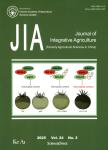Effects of long-term organic fertilization on soil microbiologic characteristics,yield and sustainable production of winter wheat
Effects of long-term organic fertilization on soil microbiologic characteristics,yield and sustainable production of winter wheat作者机构:College of Life ScienceHenan Normal University Field Scientific Observation and Research Base of Land UseMinistry of Land and Resources/Henan Polytechnic University
出 版 物:《Journal of Integrative Agriculture》 (农业科学学报(英文版))
年 卷 期:2018年第17卷第1期
页 面:210-219页
核心收录:
学科分类:09[农学]
基 金:financial support from the National Key Research and Development Program of China (2017YFD0301106,2016YFD0300203-3) the Science and Technology Innovation Team Support Plan of Universities in Hennan Province,China (18IRTSTHN008)
主 题:winter wheat long-term organic fertilization soil microbial features yield stability yield sustainability
摘 要:We investigated the soil microbiologic characteristics, and the yield and sustainable production of winter wheat, by conducting a long-term fertilization experiment. A single application of N, P and K (NPK) fertilizer was taken as the control (CK) and three organic fertilization treatments were used: NPK fertilizer+pig manure (T1), NPK fertilizer+straw return (T2), NPK fertilizer+pig manure+straw return (T3). The results showed that all three organic fertilization treatments (T1, T2 and T3) significantly increased both soil total N (STN) and soil organic carbon (SOC) from 2008 onwards. In 2016, the SOC content and soil C/N ratios for T1, T2 and T3 were significantly higher than those for CK. The three organic fertilization treatments increased soil microbial activity. In 2016, the activity of urease (sucrase) and the soil respiration rate (SRS) for T1, T2 and T3 were significantly higher than those under CK. The organic fertilization treatments also increased the content of soil microbial biomass carbon (SMBC) and microbial biomass nitrogen (SMBN), the SMBC/SMBN ratio and the microbial quotient (qMB). The yield for T1, T2 and T3 was significantly higher than that of CK, respectively. Over the nine years of the investigation, the average yield increased by 9.9, 13.2 and 17.4% for T1, T2 and T3, respectively, compared to the initial yield for each treatment, whereas the average yield of CK over the same period was reduced by 6.5%. T1, T2, and T3 lowered the coefficient of variation (CV) of wheat yield and increased the sustainable yield index (SYI). Wheat grain yield was significantly positively correlated with each of the soil microbial properties (P〈0.01). These results showed that the long-term application of combined organic and chemical fertilizers can stabilize crop yield and make it more sustainable by improving the properties of the soil.




